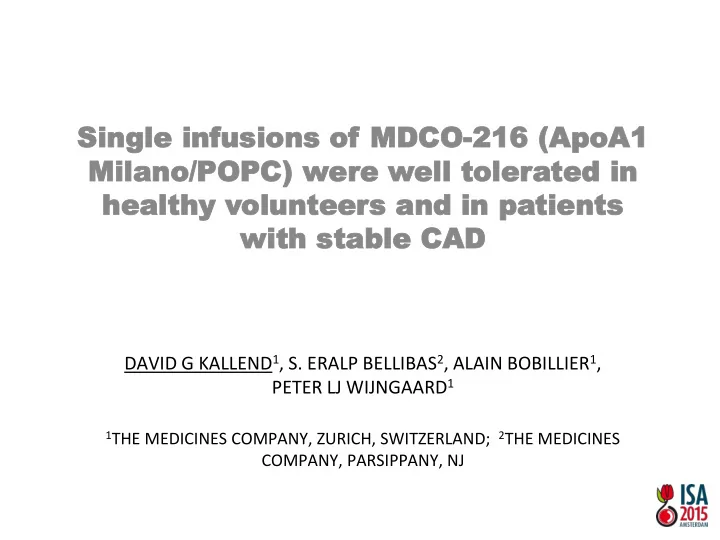

Sing Single le infusions infusions of of MDCO MDCO-21 216 6 (A (Apo poA1 A1 Milano/POP Milano /POPC) C) wer ere w e well ell to toler lerate ted d in in he health althy y volun olunte teer ers s an and in d in pa patien tients ts with stable with st ble CAD CAD DAVID G KALLEND 1 , S. ERALP BELLIBAS 2 , ALAIN BOBILLIER 1 , PETER LJ WIJNGAARD 1 1 THE MEDICINES COMPANY, ZURICH, SWITZERLAND; 2 THE MEDICINES COMPANY, PARSIPPANY, NJ
Disclosure potential conflicts of interest Research contracts: - Consulting: - Employment in industry: -The Medicines Company David Kallend, Eralp Bellibas, Alain Bobillier, Peter Wijngaard Stockholder of a -The Medicines Company healthcare company: David Kallend, Eralp Bellibas, Alain Bobillier, Peter Wijngaard Owner of a healthcare - company: Other: -
Introduction • Based on the finding that human carriers of the apolipoprotein A-1 Milano variant have a reduced incidence of cardiovascular disease 1 clinical studies were performed with ETC-216 (APO A-1 Milano/POPC manufactured by a previous process). Development of the predecessor agent ETC-216 was halted due to safety concerns. • The most significant previous finding from these studies was regression of atherosclerosis observed in an IVUS study 2 . • MDCO-216, a complex of dimeric recombinant apolipoprotein A-1 Milano (ApoA-1 M) and a phospholipid (POPC), is currently under development to potentially improve cardiovascular outcomes by reducing plaque burden in patients with atherosclerotic disease. • The purpose of this study was to assess the safety, pharmacokinetics and pharmacodynamics of newly manufactured MDCO- 216 in healthy volunteers (HVs) and coronary artery disease (CAD) patients.
Methods • Patients were enrolled and dosed in single dose cohorts as described in Figure 1. • Prior to escalation to the next dose all available data was reviewed by a Safety Review Committee and the decision taken whether to escalate to the next dose. • Following the completion of the 5 cohorts of healthy volunteers, 4 cohorts of patients with stable CAD were enrolled. • Patients were followed up in the unit for 24 hours and at regular visits until 30 days.
Baseline Characteristics • The baseline characterstics of the healthy volunteers and stable CAD patients were as expected, including the baseline lipid profile. • The majority of the stable CAD patients were on lipid lowering therapy. Table 1: Baseline demographics
Baseline Lipid Profiles Table 2: Baseline lipid profile
Pharmacodynamic Results • In both healthy volunteers and stable CAD patients, a rapid dose dependent increase in ApoA-I was observed. • Increases in phospholipid and prebeta-1 HDL and decreases in Apo E were also observed in a dose dependent manner. • Prominent and sustained increases in triglyceride, maximal at 8 hours were observed. • ABCA1 mediated cholesterol efflux was significantly increased at doses above 10 mg/kg
Safety • In total, 16 healthy volunteers and 16 stable CAD subjects received MDCO-216 in doses up to 40 mg/kg. Additionally, 8 healthy volunteers and 8 stable CAD subjects received placebo. • In no case was the infusion discontinued or interrupted because of an AE. No deaths, SAEs, or other significant AEs were reported in this trial. No AEs led to withdrawal from the study. • The most common adverse events were headache and fatigue. • No dose dependent effect on any safety parameter was noted and there was no difference in safety parameters between healthy volunteers and patients with CAD.
Adverse Events
Case History • One severe AE was observed in a 54-year-old, healthy male who received MDCO-216 30 mg/kg: suspected deep vein thrombosis (DVT) of the right popliteal vein, confirmed by ultrasound. Symptoms first occurred approximately 3 days after administration. He was treated on an outpatient basis with nadroparin, followed by phenprocoumon. Information received from his general practitioner revealed that this subject had suffered from one prior DVT and had a potentially positive family history for thrombotic events. A direct causative relation to study treatment was considered unlikely, although it cannot be ruled out. No other AEs or laboratory results suggestive of coagulopathy were observed in this study in any subject.
Laboratory Parameters • No clinically relevant changes in safety parameters were observed after infusion of MDCO-216. • Isolated, concurrent rises were seen in serum amylase and pancreatic lipase in two subjects following 10 and 20 mg/kg MDCO-216 respectively and two subjects receiving placebo. – The transient nature, magnitude, and absence of other clinical signs and symptoms do not suggest pancreatic damage or disease caused by MDCO-216.
Other Laboratory and Safety Parameters • No pro-inflammatory effect was observed after infusion of MDCO-216 in vivo or after incubation of whole blood with MDCO-216 ex vivo. No induction of anti-MDCO-216 antibody was observed after infusion of MDCO-216. • A total of 240 serum samples were obtained at time 0 (Day1) and Days 2, 3, 7 and 30 from all subjects for anti-MDCO-216 antibody detection using a validated ELISA. No anti-MDCO- 216 antibody was detected in any of the dose levels at any time point. • In addition, no changes were observed in urinalysis, vital signs, ECGs or physical examination.
Conclusions • MDCO-216 was well tolerated with no serious adverse events and no other significant adverse safety findings including laboratory parameters, vital signs and ECGs. • The most common adverse events were headache and fatigue. • No dose dependent effect on any safety parameter was noted and there was no difference in safety parameters between healthy volunteers and patients with CAD. • These data support further development of this agent as a disease-modifying treatment for reducing atherosclerotic disease and subsequent cardiovascular events. References: 1.G Franceschini, C R Sirtori, et al J Clin Invest. 1980;66(5):892 – 900 2. Nissen S et al; JAMA Nov 2003 Vol 290 no 17 p2292 – 2300
Recommend
More recommend